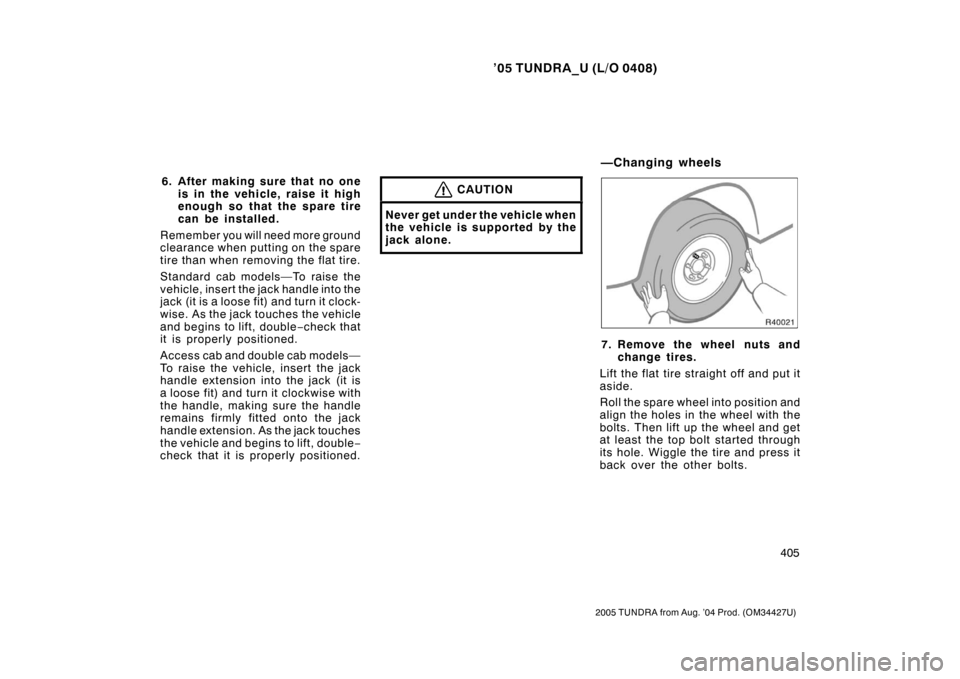Page 399 of 506

’05 TUNDRA_U (L/O 0408)
388
2005 TUNDRA from Aug. ’04 Prod. (OM34427U)
�Always place wheel blocks under both
the vehicle and trailer wheels when
parking. Apply the parking brake firmly.
Put the transmission in “P” (automatic)
or in first or reverse (manual). Avoid
parking on a slope with a trailer, but
if it cannot be avoided, do so only
after performing the following:
1. Apply the brakes and hold.
2. Have someone place wheel blocks un- der both the vehicle and trailer wheels.
3. When the wheel blocks are in place, release your brakes slowly until the
blocks absorb the load.
4. Apply the parking brake firmly.
5. Shift into first or reverse (manual) or “P” (automatic) and turn off the engine. When restarting out after parking on a
slope:
1. With the transmission in “P” position (automatic) or the clutch pedal de-
pressed (manual), start the engine.
(With an automatic transmission, be
sure to keep the brake pedal de-
pressed.)
2. Shift into gear.
3. Release the parking brake (also foot brake on automatic transmission ve-
hicles) and slowly pull or back away
from the wheel blocks. Stop and apply
your brakes.
4. Have someone retrieve the blocks.CAUTION
�Do not exceed 72 km/h (45 mph) or
the posted towing speed limit,
whichever is lower. Because insta-
bility (swaying) of a towing vehicle −
trailer combination usually in-
creases as the speed increases, ex-
ceeding 72 km/h (45 mph) may
cause loss of control.
�Slow down and downshift before
descending steep or long downhill
grades. Do not make sudden down-
shifts.
�Avoid holding the brake pedal down
too long or too frequently. This
could cause the brakes to overheat
and result in reduced braking effi-
ciency.
Page 400 of 506

’05 TUNDRA_U (L/O 0408)
389
2005 TUNDRA from Aug. ’04 Prod. (OM34427U)
Improving fuel economy is easy—just take
it easy. It will help make your vehicle last
longer, too. Here are some specific tips
on how to save money on both fuel and
repairs:
�Keep your tires inflated at the cor-
rect pressure. Underinflation causes
tire wear and wastes fuel. See Section
7 −2 for instructions.
�Do not carry unneeded weight in
your vehicle. Excess weight puts a
heavier load on the engine, causing
greater fuel consumption.
�Avoid lengthy warm −up idling. Once
the engine is running smoothly, begin
driving—but gently. Remember, howev-
er, that on cold winter days this may
take a little longer.
�Always keep the automatic transmis-
sion overdrive switch turned on.
Driving with the overdrive switch off
will reduce the fuel economy. (For de-
tails, see “Automatic transmission” in
Section 1 −7.)
�Accelerate slowly and smoothly.
Avoid jackrabbit starts. Get into high
gear as quickly as possible.
�Avoid long engine idling. If you have
a long wait and you are not in traffic,
it is better to turn off the engine and
start again later.
�Avoid engine lugging or over −rev-
ving. Use a gear position suitable for
the road on which you are travelling.
�Avoid continuous speeding up and
slowing down. Stop−and− go driving
wastes fuel.
�Avoid unnecessary stopping and
braking. Maintain a steady pace. Try
to time the traffic signals so you only
need to stop as little as possible or
take advantage of through streets to
avoid traffic lights. Keep a proper dis-
tance from other vehicles to avoid sud-
den braking. This will also reduce wear
on your brakes.
�Avoid heavy traffic or traffic jams
whenever possible.
�Do not rest your foot on the clutch
or brake pedal. This causes premature
wear, overheating and poor fuel econo-
my.
�Maintain a moderate speed on high-
ways. The faster you drive, the greater
the fuel consumption. By reducing your
speed, you will cut down on fuel con-
sumption.
�Keep the front wheels in proper
alignment. Avoid hitting the curb and
slow down on rough roads. Improper
alignment not only causes faster tire
wear but also puts an extra load on
the engine, which, in turn, wastes fuel.
�Keep the bottom of your vehicle free
from mud, etc. This not only lessens
weight but also helps prevent corro-
sion.
�Keep your vehicle tuned −up and in
top shape. A dirty air cleaner,
improper valve clearance, dirty plugs,
dirty oil and grease, brakes not
adjusted, etc. all lower engine
performance and contribute to poor fuel
economy. For longer life of all parts
and lower operating costs, keep all
maintenance work on schedule, and if
you often drive under severe
conditions, see that your vehicle
receives more frequent maintenance.
(For scheduled maintenance informa-
tion, please refer to the “Scheduled
Maintenance Guide” or “Owner ’s
Manual Supplement”.)
How to save fuel and make
your vehicle last longer
Page 409 of 506

’05 TUNDRA_U (L/O 0408)
398
2005 TUNDRA from Aug. ’04 Prod. (OM34427U)
CAUTION
When jacking, be sure to observe
the following to reduce the possi-
bility of personal injury:
�Follow jacking instructions.
� Do not put any part of your
body under the vehicle sup-
ported by the jack. Otherwise,
personal injury may occur.
� Do not start or run the engine
while your vehicle is supported
by the jack.
� Stop the vehicle on a level firm
ground, firmly set the parking
brake and put the transmission
in “P” (automatic) or reverse
(manual). Block the wheel diag-
onally opposite to the one be-
ing changed if necessary.
�Make sure to set the jack prop-
erly in the jack point. Raising
the vehicle with jack improper-
ly positioned will damage the
vehicle or may allow the ve-
hicle to fall off the jack and
cause personal injury.
� Never get under the vehicle
when the vehicle is supported
by the jack alone.
� Use the jack only for lifting
your vehicle during wheel
changing.
� Do not raise the vehicle with
someone in the vehicle.
� When raising the vehicle, do
not place any objects on top
of or underneath the jack.
� Raise the vehicle only high
enough to remove and change
the tire.NOTICE
Do not continue driving with a
deflated tire. Driving even a
short distance can damage a
tire and wheel beyond repair.
Page 410 of 506

’05 TUNDRA_U (L/O 0408)
399
2005 TUNDRA from Aug. ’04 Prod. (OM34427U)
1. Get the required tools and
spare tire.
1 Jack handle
2 Wheel nut wrench
3Jack
To prepare yourself for an emergency,
you should familiarize yourself with
the use of the jack, each of the tools
and their storage locations.Turn the jack joint by hand.
To rem ov e: Tur n the joint in direction
1 until the jack is free.
To store: Turn the joint in direction 2
until the jack is fi rmly secured to pre-
vent it flying forward during a collision
or sudden braking.To remove the spare tire:
1. Insert the end of the jack handle
into the lowering screw and turn
it counterclockwise.
2. After the tire is lowered completely to the ground, remove the holding
bracket.
When storing the spare tire, put it in
place with the outer side of the wheel
facing up. Then secure the tire, taking
care that the tire goes straight up
without catching on any other part, to
prevent it from flying forward during
a collision or sudden braking.
—Required tools and spare tire
(standard cab models)
Page 412 of 506

’05 TUNDRA_U (L/O 0408)
401
2005 TUNDRA from Aug. ’04 Prod. (OM34427U)
To remove the spare tire:
1. Put a jack handle, jack handle ex- tension and jack handle end to-
gether as shown in the illustration.
1 Jack handle end
2 Jack handle extension
3 Jack handle
CAUTION
Make sure they are securely fixed
with the screw.
2. Insert the end of the jack handleextension into the lowering screw
and turn it counterclockwise with
the handle.
3. After the tire is lowered completely to the ground, remove the holding
bracket.
When storing the spare tire, put it in
place with the outer side of the wheel
facing up. Then secure the tire, taking
care that the tire goes straight up
without catching on any other part, to
prevent it from flying forward during
a collision or sudden braking.2. Block the wheel diagonally op- posite the flat tire to keep the
vehicle from rolling when it is
jacked up.
When blocking the wheel, place a
wheel block in front of one of the front
wheels or behind one of the rear
wheels.
—Blocking the wheel
Page 413 of 506
’05 TUNDRA_U (L/O 0408)
402
2005 TUNDRA from Aug. ’04 Prod. (OM34427U)
Ty p e A
Ty p e B
Ty p e C
Ty p e D
Ty p e E
3. Remove the wheel ornament.
Pry off the wheel ornament, using the
beveled end of the wheel nut wrench
as shown.
Ty pe B only — To pr ot ec t the wheel
surface, place sufficient paper or cloth
between the wheel and wrench.
—Removing wheel ornament
Page 414 of 506
’05 TUNDRA_U (L/O 0408)
403
2005 TUNDRA from Aug. ’04 Prod. (OM34427U)
CAUTION
Do not try to pull off the orna-
ment by hand. Take due care in
handling the ornament to avoid
unexpected personal injury.
4. Loosen all the wheel nuts.
Always loosen the wheel nuts before
raising the vehicle.
Turn the wheel nuts counterclockwise
to loosen. To get maximum leverage,
fit the wrench to the nut so that the
handle is on the right side, as shown
above. Grab the wrench near the end
of the handle and pull up on the han-
dle. Be careful that the wrench does
not slip off the nut.
Do not remove the nuts yet—just un-
screw them about one −half turn.
CAUTION
Never use oil or grease on the
bolts or nuts. The nuts may loose
and the wheels may fall off,
which could cause a serious ac-
cident.
—Loosening wheel nuts
Page 416 of 506

’05 TUNDRA_U (L/O 0408)
405
2005 TUNDRA from Aug. ’04 Prod. (OM34427U)
6. After making sure that no one
is in the vehicle, raise it high
enough so that the spare tire
can be installed.
Remember you will need more ground
clearance when putting on the spare
tire than when removing the flat tire.
Standard cab models—To raise the
vehicle, insert the jack handle into the
jack (it is a loose fit) and turn it clock-
wise. As the jack touches the vehicle
and begins to lift, double− check that
it is properly positioned.
Access cab and double cab models—
To raise the vehicl e, insert the jack
handle extension into the jack (it is
a loose fit) and turn it clockwise with
the handle, making sure the handle
remains firmly fitted onto the jack
handle extension. As the jack touches
the vehicle and begins to lift, double −
check that it is properly positioned.CAUTION
Never get under the vehicle when
the vehicle is supported by the
jack alone.
7. Remove the wheel nuts and
change tires.
Lift the flat tire straight off and put it
aside.
Roll the spare wheel into position and
align the holes in the wheel with the
bolts. Then lift up the wheel and get
at least the top bolt started through
its hole. Wiggle the tire and press it
back over the other bolts.
—Changing wheels